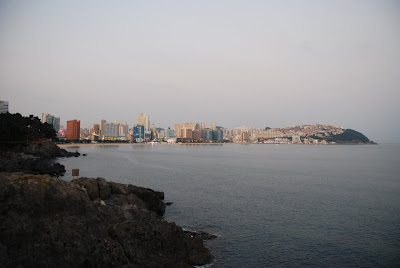 Busan is Korea's second largest city, and one of the world's five largest ports. This becomes noticeable for example when traveling by subway; after a short 40-minutes bus ride from Gyeongju to Busan, it took me a full hour to make my way across town to Haeundae, where I was going to meet Haeyoung. Thanks to Ji-whan's planning and hand-drawn map of the subway system, this proved to be simple enough. I arrived on time, and without any major detours, and had just enough time to make a phone call and buy some iced tea from a street vendor, before Haeyoung picked me up. We left my luggage in her car, and went directly to Haeundae's namesake beach, a summer favorite that draws up to a hundred thousand sunbathing visitors from all of Korea, not all of which can conceivably touch sand at the same time.
Busan is Korea's second largest city, and one of the world's five largest ports. This becomes noticeable for example when traveling by subway; after a short 40-minutes bus ride from Gyeongju to Busan, it took me a full hour to make my way across town to Haeundae, where I was going to meet Haeyoung. Thanks to Ji-whan's planning and hand-drawn map of the subway system, this proved to be simple enough. I arrived on time, and without any major detours, and had just enough time to make a phone call and buy some iced tea from a street vendor, before Haeyoung picked me up. We left my luggage in her car, and went directly to Haeundae's namesake beach, a summer favorite that draws up to a hundred thousand sunbathing visitors from all of Korea, not all of which can conceivably touch sand at the same time.
Haeundae has seen a nearly incredible amount of development in the last five years, including the construction of Gwangan bridge.

Since we both hadn't eaten, Haeyoung then took me to the the place to go for fresh eel. The eel are kept alive in a tank just outside the restaurant until the moment you place your order.

At that point, they are killed and filleted, and stewed on a cooker on your table. Eventually the pieces stop moving and are ready to eat - they have a chewy texture, a desired trait in Korean cuisine.
It was one of the last days of the Busan Film Festival (PIFF), and Haeundae Beach was filled with booths that were all at least loosely related to the movie industry. We took a stroll along them after dinner, and happened upon a performance of traditional Korean music - part of a PIFF-related reception. A brass instrument, whose sound reminded me of a Shawm or Schalmei, accompanied by four percussion instruments, playing groovy, stomping, pounding rhythms, and dancing: a man - maybe the fool?, a bear - or at least two men in a bear costume, and at the end the musicians themselves, who circled, jumped and turned like dervishes, the long ... on their hats describing coordinated circles and figure eights. What struck me as remarkable, is that I would have placed this music much further west, had I heard it out of context - I would have guessed it to be from Turkey, or somewhere along the silk road perhaps.
After that, we walked back to the car, had another look at Gwangan bridge by night, and drove to Haeyoung's home in the outskirts of Busan.

The next day - Haeyoung had to work - was filled with sightseeing. One of the things Busan is known for is the Jagalchi fish market, an immense collection of stalls and restaurants, partly in the road, partly in a newly opened market hall, and ships in all sizes and shapes.

Jagalchi's focus is on fish, but that doesn't mean you can't get everything else too. At the outer reaches you'll find stores full of traditional Asian medicine (this time I was quick-witted enough to take a picture of the dried frogs), and any supplies fishermen may need; ropes, chains, nets, and so on.

Closer to the center of the market are the dried fish stalls.

Tiny dried fish, small dried fish, big dried fish, dried seaweed, dried squid, dried octopus - if you can dry it, you can find it here.

At the heart of Jagalchi are the fresh fish stalls, and of course live fish, and crab, mussel, clam, squid, snail and turtle.

Walk on past the restaurants that sell fish and other seafood, fried, stewed, and of course raw, and you'll get to the vegetable and fruit part of Jagalchi, where there's cabbage, leek, carrots, potatos, dubu (or tofu), lettuce, sesame leaves, garlic, onions, hot peppers and of course kimchi. And then, as you are about to emerge from this jumble of color and smells, there are more medicine stalls with their powders, roots, barks, leaves, mushrooms, seaweeds and, again, dried frogs.

In the afternoon I went for a hike in Geumgang, a mountain park in the northern part of Busan. It turned out to be quite hard to find, as I had forgotten to pack my guide book when I left Gyeongju, and was navigating only from a tourist map of Busan. I took the metro to what I thought was a nearby station, and walked in the general direction of the mountain, which thankfully distinguishes itself from all the other hills in and around Busan by the red supports of its cable-car. Busan's road system was not kind to me, and gradually turned me away until I was walking in a completely useless direction; but eventually I made it to the entrance of the park. I decided to walk up, rather than take the cable-car, and was rewarded on the way with a magnificent view of the sprawling Busan.


No comments:
Post a Comment